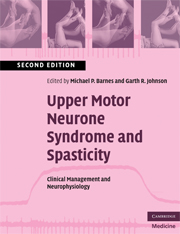Book contents
- Frontmatter
- Contents
- List of Contributors
- Preface to the second edition
- 1 An overview of the clinical management of spasticity
- 2 Neurophysiology of spasticity
- 3 The measurement of spasticity
- 4 Physiotherapy management of spasticity
- 5 Seating and positioning
- 6 Orthoses, splints and casts
- 7 Pharmacological management of spasticity
- 8 Chemical neurolysis in the management of muscle spasticity
- 9 Spasticity and botulinum toxin
- 10 Intrathecal baclofen for the control of spinal and supraspinal spasticity
- 11 Surgical management of spasticity
- 12 Management of spasticity in children
- Index
- References
12 - Management of spasticity in children
Published online by Cambridge University Press: 22 August 2009
- Frontmatter
- Contents
- List of Contributors
- Preface to the second edition
- 1 An overview of the clinical management of spasticity
- 2 Neurophysiology of spasticity
- 3 The measurement of spasticity
- 4 Physiotherapy management of spasticity
- 5 Seating and positioning
- 6 Orthoses, splints and casts
- 7 Pharmacological management of spasticity
- 8 Chemical neurolysis in the management of muscle spasticity
- 9 Spasticity and botulinum toxin
- 10 Intrathecal baclofen for the control of spinal and supraspinal spasticity
- 11 Surgical management of spasticity
- 12 Management of spasticity in children
- Index
- References
Summary
Introduction
Spasticity can be defined as a velocity-dependent resistance to passive movement of a joint and its associated musculature (Lance, 1980; Rymer & Powers, 1989; Massagli, 1991). Although spasticity is usually present before contracture in children with cerebral palsy, true muscle shortening or contracture also appears at an early stage. The majority of children will have a mixture of spasticity and contracture. Distinguishing spasticity from contracture is important from a management point of view.
‘Dynamic’ shortening is most commonly caused by spasticity but may also be associated with dystonia and mixed movement disorders. Typically, ‘dynamic’ contracture is recognized in younger children with cerebral palsy or spasticity of recent onset. Such children are likely to exhibit hyperreflexia, clonus, co-contraction and a velocity-dependent resistance to passive joint motion. Children who exhibit ‘dynamic’ calf shortening may walk on their toes with an equinus gait, but on the examination couch the range of passive ankle dorsiflexion may be full or almost full.
‘Fixed’ shortening or ‘myostatic’ contracture describes the typical stiffness found in muscles of older children with cerebral palsy or spasticity of longer duration. The stiffness is much less velocity dependent and is still present during couch examination and under anaesthesia.
Causes of spasticity in children
With the eradication of poliomyelitis and the dramatic fall in the prevalence of spina bifida, the most common motor disorder in children in developed countries is cerebral palsy. The incidence of cerebral palsy in developed countries is static or even rising.
Keywords
- Type
- Chapter
- Information
- Upper Motor Neurone Syndrome and SpasticityClinical Management and Neurophysiology, pp. 214 - 240Publisher: Cambridge University PressPrint publication year: 2008
References
- 3
- Cited by



